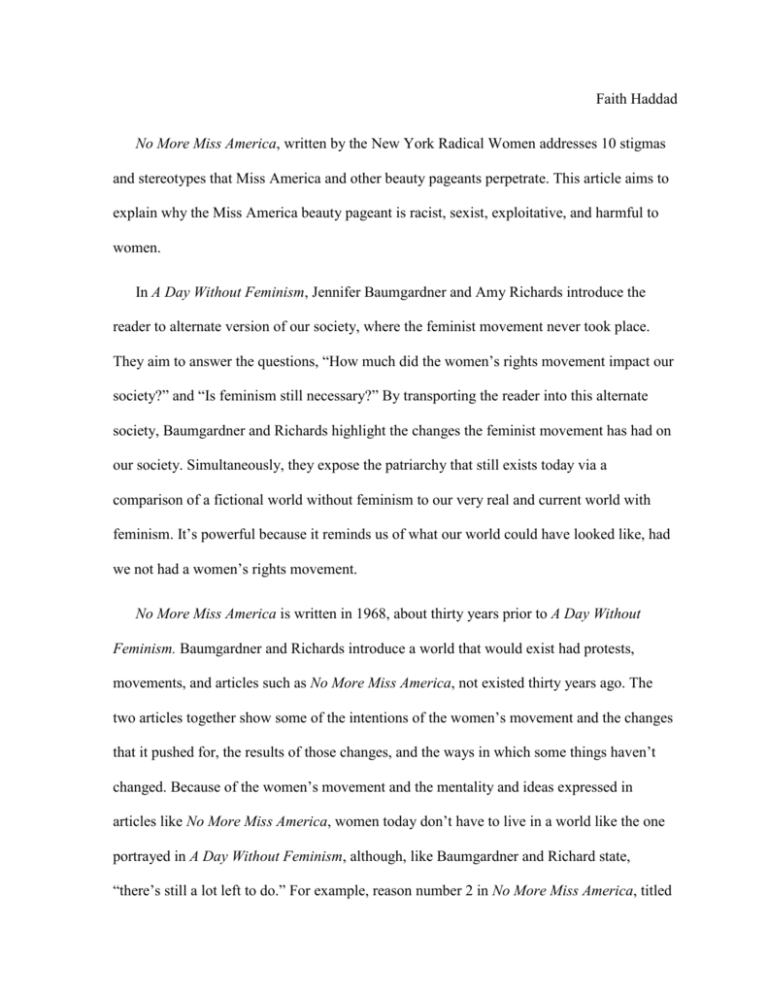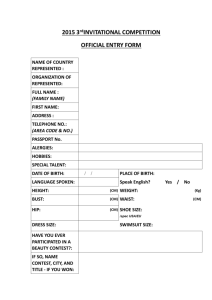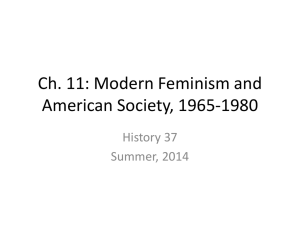
Faith Haddad
No More Miss America, written by the New York Radical Women addresses 10 stigmas
and stereotypes that Miss America and other beauty pageants perpetrate. This article aims to
explain why the Miss America beauty pageant is racist, sexist, exploitative, and harmful to
women.
In A Day Without Feminism, Jennifer Baumgardner and Amy Richards introduce the
reader to alternate version of our society, where the feminist movement never took place.
They aim to answer the questions, “How much did the women’s rights movement impact our
society?” and “Is feminism still necessary?” By transporting the reader into this alternate
society, Baumgardner and Richards highlight the changes the feminist movement has had on
our society. Simultaneously, they expose the patriarchy that still exists today via a
comparison of a fictional world without feminism to our very real and current world with
feminism. It’s powerful because it reminds us of what our world could have looked like, had
we not had a women’s rights movement.
No More Miss America is written in 1968, about thirty years prior to A Day Without
Feminism. Baumgardner and Richards introduce a world that would exist had protests,
movements, and articles such as No More Miss America, not existed thirty years ago. The
two articles together show some of the intentions of the women’s movement and the changes
that it pushed for, the results of those changes, and the ways in which some things haven’t
changed. Because of the women’s movement and the mentality and ideas expressed in
articles like No More Miss America, women today don’t have to live in a world like the one
portrayed in A Day Without Feminism, although, like Baumgardner and Richard state,
“there’s still a lot left to do.” For example, reason number 2 in No More Miss America, titled
‘Racism with Roses’ discusses the notion that Miss America doesn’t represent real
Americans. Ideal beauty (and therefore worth) is colonial beauty and belongs only to those
who are white. By 1968, there hadn’t been a single finalist who wasn’t white. In A Day
Without Feminism Baumgardner and Richard explore representation of diversity, or rather,
the lack there-of, in university courses in a society without feminism and conclude that “the
absence of [such studies] from college curricula implies that they are not worth studying.”
This notion of worth directly correlates to the very real notion of a woman’s worth in No
More Miss America. And while the women’s rights movement has made great strides in this
area, there is still this persistent standard of “ideal beauty” that impacts the women of our
society. Ethnic women go to great lengths to relax or perm their hair, in such a way that
mimics the texture and style of an Anglo-Saxon woman’s hair, an alarming percentage of
young women struggle with eating disorders, and when Nina Davuluri won Miss America
(just last year) in 2014, xenophobic and racist comments flooded social media sites.
No More Miss America challenges the perception that sexuality and beauty is for the
young by asking the question, “What is so ignored as last year’s Miss America? Women
must be young, juicy, malleable-hence age discrimination and the cult of youth.” In A Day
Without Feminism, Baumgardner and Richard examine the requirements for a job as a flight
attendant (or stewardess); “sex appeal is a job requirement, wearing makeup is a rule, and
women are fired if they exceed the age or weight limit deemed sexy.” While the requirements
for being a flight attendant have changed, some of these ideas still exist. The majority of
flight attendants are women, the role of the sexy stewardess is common in movies,
pornography, and Halloween costumes and female flight attendants still endure a barrage of
sexual harassment.
No More Miss America also addresses the idea of the “unbeatable Madonna-Whore
combination” and how absolutely unattainable and contradictory the ‘requirements’ are to
“win approval.” In particular, I want to focus on the notion that women must be “both sexy
and wholesome.” A woman must appear sexy, but she must never actually be sexual. This
idea perpetuates the stigma that a woman’s purpose is to serve men. Her body exists, not for
herself, but for a man’s pleasure. A Day Without Feminism also address this issue by
explaining the implications of having sex outside of marriage. Girls who participate in
premarital sex are “ruining their chances of finding a guy full-time, and they’re probably
getting a bad reputation.” Again, we see here the notion that women exist for men and are
worth less without one.
No More Miss America and A Day Without Feminism complement each other well. Each
article is its own, but comparing them side by side allows for a unique perspective on the
original goals of the women’s movement in the early 70’s, the impact it had, how things have
changed because of feminism and how they still need to change.
One particular quote in A Day Without Feminism intrigued me. When Baumgardner and
Richards introduce the setting to their society without feminism, they talk about the radio and
kitchen appliances and they say, “The name of your Whirlpool gas stove is Mrs. America.”
By calling the appliance “Mrs. America” Baumgardner and Richards convey a powerful
message; by conforming to the ideal beauty standards of Miss America, a woman can reach
her ‘utmost potential’ and become Mrs. America, the perfect domesticated housewife. The
standards that the Miss America beauty pageant sets for women, the goals it promotes and
the values it instils contribute greatly to the oppression of women. Miss America still exists
today and we still do have a lot of work to do.







